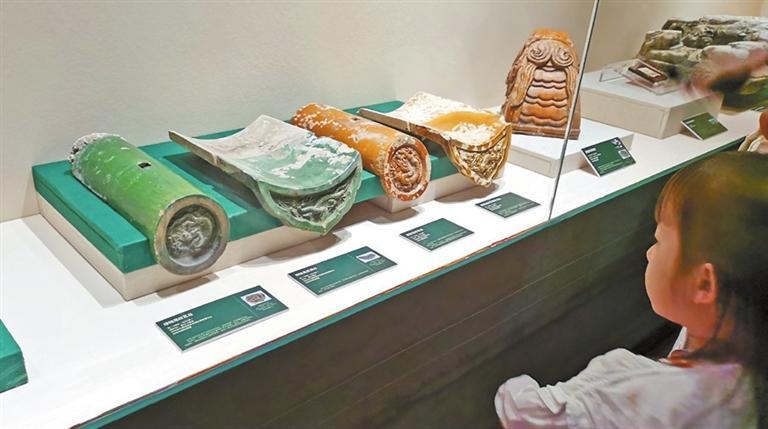
A child observes Ming Dynasty architectural fragments at the exhibition.
Exhibitions showcasing the Ming Dynasty (1368-1644) imperial lives usually present treasures crafted for emperors and empresses, such as stunning gold crowns, resplendent accessories adorned with shimmering gems, or porcelain pieces exhibiting exquisite craftsmanship, reflecting an era characterized by economic prosperity and cultural opulence.
Now visitors can admire the Ming splendor at a new exhibition which shines a spotlight on the Ming princes residing in feudal domains.

A visitor in a traditional Chinese garment admires a rubbing work.
The “Special Exhibition on Cultural Relics of Ming Dynasty Imperial Clans From Hubei” at Shenzhen Museum’s Ancient Art Division showcases 250 relics sourced from 10 museums and cultural organizations in Central China’s Hubei Province, illuminating the historical and cultural significance of the Ming enfeoffment practices.
After Zhu Yuanzhang established the Ming Dynasty, he enfeoffed his sons as vassal princes to be stationed in strategic locations across the country to consolidate imperial power and ensure defense. These princes, granted autonomy in their own fiefs, played crucial roles in safeguarding the throne.

A visitor observes a Ming Dynasty crown at the exhibition at Shenzhen Museum’s Ancient Art Division.
The Huguang region (modern-day Hubei and Hunan provinces), emerged as a pivotal area for enfeoffment during the Ming Dynasty, due to its geographical importance and thriving economy. Hubei became home to a total of 44 princes, with 12 establishing their fiefs in this region, thus spawning branches that left a profound impact on the dynasty.
At the exhibition, magnificent gold accessories and utensils, delicate blue-and-white porcelain pieces, and architectural fragments intricately carved with dragon motifs not only reflect the opulence and prestige of the princes and princesses but also underscore the exceptional craftsmanship of the era.

A Ming Dynasty gold pot is on display.
Moreover, a diverse collection of stationery and objects crafted for leisure and aesthetic appreciation offers an insight into the princes’ refined tastes, embodying a world intertwined with literary and artistic elegance. These artifacts offer a glimpse into the lives, spiritual pursuits, and artistic preferences of these imperial figures.

Visitors admire an array of Ming Dynasty porcelain pieces.
Dates: Through July 28
Booking: WeChat miniprogram “深圳博物馆”
Venue: Shenzhen Museum’s Ancient Art Division, Futian District (深圳博物馆古代艺术馆)
Metro: Line 9 to Hongling South Station (红岭南站), Exit A